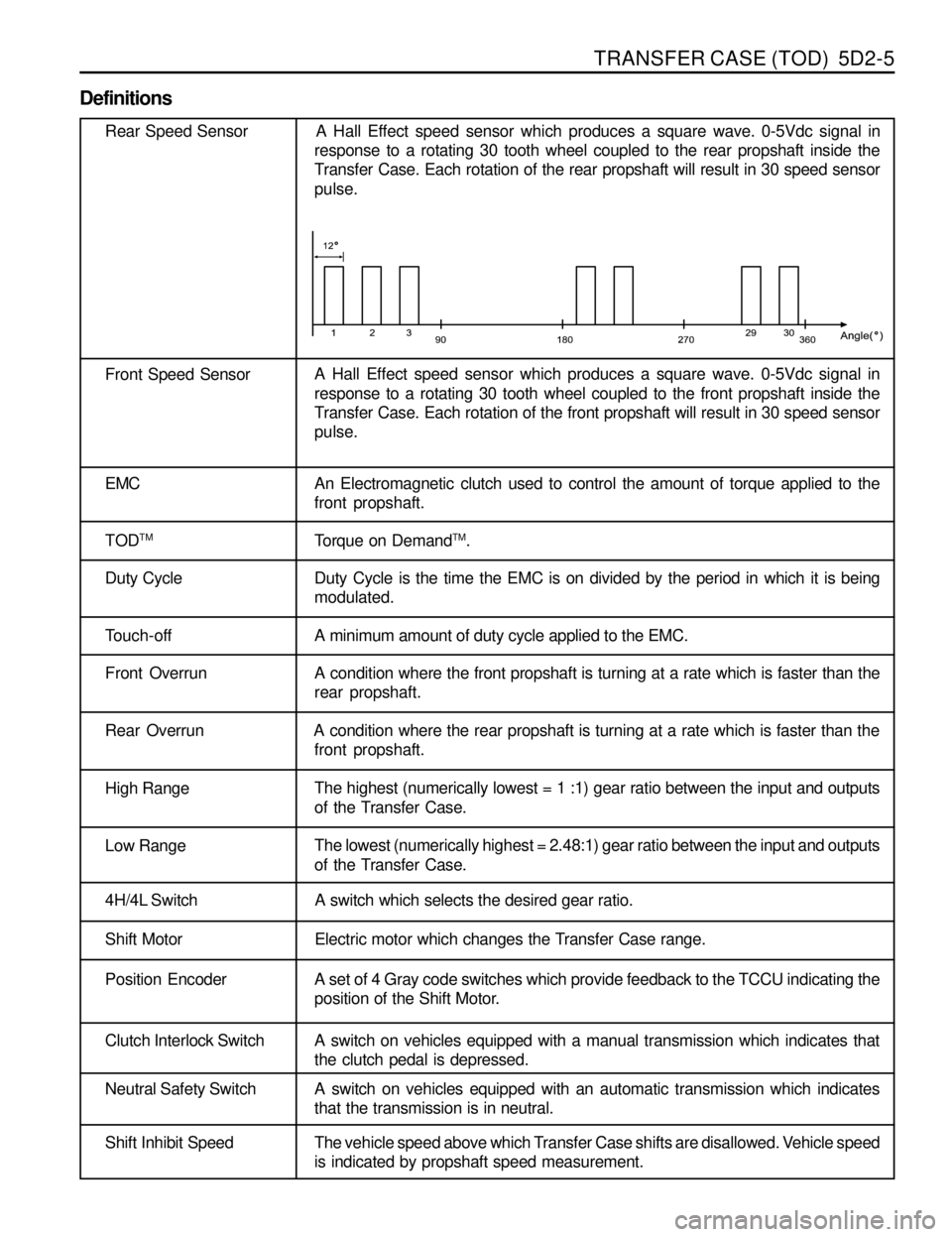Page 942 of 1463
4D-4 FRONT DISC BRAKES
5. Pull out the brake pads. Replace pads if necessary.
Notice
Always change the all pads on one wheel at a time.
6. Installation should follow the removal procedure in the
reverse order.
7. Bleed the air from the system.
Page 943 of 1463
FRONT DISC BRAKES 4D-5
4. Measure rotor disc thickness.
UNIT REPAIR
FRONT DISC BRAKE
Inspection Procedure
1. Clean all components and visually check the followings.
lCheck the cylinder and piston for wear, rust or damage.
lCheck the caliper body and guide pin for wear, damage
or crank.
lCheck the pads for uneven wear or oiliness.
lCheck the boots for damage or tear.
2. Measure caliper housing inner diameter.
Item
With PBR
With MANDOWear Limit
f 61.4 mm
f 61.0 mm
Standard
10 mmWear Limit
2.0 mm
Standard
f 60.4 mm
f 60.0 mm
3. Measure pad thickness.
Notice
Always change the all pads on one wheel at a time.
5. Check the rotor disc for score or runout.
Standard
24 mmWear Limit
22 mm
Page 946 of 1463
REAR DISC BRAKES 4E-3
Tightening Torque 15 - 18 Nm
Tightening Torque 85 - 105 Nm
Removal & Installation Procedure
1. Remove the eye-hose bolt and disconnect the hose.
Installation Notice
2. Unscrew the mounting bolts and remove the brake caliper
assembly.
Installation Notice
3. Pull out the brake pads. Replace pads if necessary.
Notice
Always change the all pads on one wheel at a time.
4. Installation should follow the removal precedure in the
reverse order.
5. Bleed the air from the system.
Page 947 of 1463
4E-4 REAR DISC BRAKES
Standard
10.4 mmWear Limit
9.3 mm
UNIT REPAIR
REAR DISC BRAKE
Inspection Procedure
1. Clean all components and visually check the followings.
lCheck the cylinder and piston for wear, rust or damage.
lCheck the caliper body and guide pin for wear, damage
or crank.
lCheck the pads for uneven wear or oiliness.
lCheck the boots for damage or tear.
Standard
f40.5 mm
f38.2 mmWear Limit
f41.5 mm
f39.2 mm
2. Measure caliper housing inner diameter.
3. Measure pad thickness.
Standard
9.5 mmWear Limit
2.0 mm
Notice
Always change the all pads on one wheel at a time.
4. Measure rotor disc thickness.
5. Check the rotor disc for score or runout.
Item
With PBR
With MANDO
Page 1211 of 1463

5D2-4 TRANSFER CASE (TOD)
FUNCTION DESCRIPTION
lTOD System Select Mode (4H and 4L)
4H is the mode when drive normally of which gear ratio is 1:1 and 4L mode distributes power to front and rear
wheels 50:50 of which gear ratio is 2.48:1.
lTOD System Function (select 4H mode)
TOD system controls clutch mechanism to comply with rotation in front and rear propeller shaft and if its difference
exceeds the permissible range, corresponding power is distributed into front wheel through EMC (Electro-Magnetic
Clutch).
Hall effect sensor signals speed on front and rear propeller shafts going through with TOD control unit.
Transfercase clutch coil is activated by variable current on exceeding difference of speed in front and rear propeller
shafts.
lFunction of 4L Mode
When select 4L mode, EMC is locked to apply maximum torque into front and rear propeller shafts. Shift motor
rotates also 4L position by rotation of cam thus propeller shaft torque changes from 1:1 to 2.48:1 by planetary
gear set.
lShift Motor
It locates backside transfer case, which drives rotary helical cam.
When mode select switch changes to 4L, shift fork is on position for 2.48:1 by rotation of helical cam.
lTransfer Case
TOD transfer case distributes power into front and rear axle by operation of 4H/4L switch and shift motor.
Shifting 4H to 4L, is performed towards reducing HI-LO collar by means for connection HI-LO shift fork with
output shaft in order to join with planetary gear. Torque transmits input shaft then sun gear rotating front planetary
gear. Front planetary gear join with output shaft and drives LO position.
Page 1212 of 1463

TRANSFER CASE (TOD) 5D2-5
Definitions
Rear Speed Sensor A Hall Effect speed sensor which produces a square wave. 0-5Vdc signal in
response to a rotating 30 tooth wheel coupled to the rear propshaft inside the
Transfer Case. Each rotation of the rear propshaft will result in 30 speed sensor
pulse.
Front Speed SensorA Hall Effect speed sensor which produces a square wave. 0-5Vdc signal in
response to a rotating 30 tooth wheel coupled to the front propshaft inside the
Transfer Case. Each rotation of the front propshaft will result in 30 speed sensor
pulse.
EMC An Electromagnetic clutch used to control the amount of torque applied to the
front propshaft.
TOD
TMTorque on DemandTM.
Duty Cycle Duty Cycle is the time the EMC is on divided by the period in which it is being
modulated.
Touch-off A minimum amount of duty cycle applied to the EMC.
Front OverrunA condition where the front propshaft is turning at a rate which is faster than the
rear propshaft.
Rear Overrun A condition where the rear propshaft is turning at a rate which is faster than the
front propshaft.
High RangeThe highest (numerically lowest = 1 :1) gear ratio between the input and outputs
of the Transfer Case.
Low RangeThe lowest (numerically highest = 2.48:1) gear ratio between the input and outputs
of the Transfer Case.
4H/4L Switch A switch which selects the desired gear ratio.
Shift Motor Electric motor which changes the Transfer Case range.
Position Encoder A set of 4 Gray code switches which provide feedback to the TCCU indicating the
position of the Shift Motor.
Clutch Interlock Switch A switch on vehicles equipped with a manual transmission which indicates that
the clutch pedal is depressed.
Neutral Safety Switch A switch on vehicles equipped with an automatic transmission which indicates
that the transmission is in neutral.
Shift Inhibit Speed The vehicle speed above which Transfer Case shifts are disallowed. Vehicle speed
is indicated by propshaft speed measurement.
Page 1261 of 1463

Application
Steering Wheel
Steering Gear Box
Oil Pump
Steering Column
Minmum Turning Radius
Oil
SECTION 6A
POWER STEERING SYSTEM
TABLE OF CONTENTS
Specifications . . . . . . . . . . . . . . . . . . . . . . . . 6A-1
General Specifications . . . . . . . . . . . . . . . . . . 6A-1
Fastener Tightening Specifications . . . . . . . . . 6A-1
Diagnosis . . . . . . . . . . . . . . . . . . . . . . . . . . . 6A-2
Hard Steering . . . . . . . . . . . . . . . . . . . . . . . . . 6A-2
Steering Pulls to One Side . . . . . . . . . . . . . . . 6A-2
Excessive Wheel Play . . . . . . . . . . . . . . . . . . . 6A-2
Poor Return of Steering Wheel . . . . . . . . . . . . 6A-2
Steering Wheel Shimmy . . . . . . . . . . . . . . . . . 6A-3
SPECIFICATIONS
GENERAL SPECIFICATIONS
Abnormal Noise From Steering System . . . . . 6A-3
Component Locator . . . . . . . . . . . . . . . . . . . 6A-4
Steering System . . . . . . . . . . . . . . . . . . . . . . . 6A-4
Maintenance and Repair . . . . . . . . . . . . . . . 6A-5
On-Vehicle Service . . . . . . . . . . . . . . . . . . . . . 6A-5
Inspection . . . . . . . . . . . . . . . . . . . . . . . . . . . . 6A-5
Oil Pump Pressure Check . . . . . . . . . . . . . . . . 6A-6
Bleeding of Power Steering System . . . . . . . . 6A-6
Steering Gear Box . . . . . . . . . . . . . . . . . . . . . 6A-7
Number of Spoke
Outer Diameter
Type
Gear Ratio
Inner Steering Angle
Outer Steering Angle
Type
Maximum Pressure
Upper Tilting Angle
Lower Tilting Angle
Type
Capacity
Change Interval
Description
4
396 mm
Rack and Pinion
¥
33°37'
31°50'
Vane
75-82 kg/cm
2
4.646°
6.969°
5.25m
ATF DEXRON II
1 L
Every 24,000 km
FASTENER TIGHTENING SPECIFICATIONS
Application
Steering Shaft Bolt
Pressure Hose Bolt
Return Pipe Nut
Slotted Nut
Steering Gearbox BoltNlm
30 - 40
12 - 18
12 - 18
35 - 45
35 - 45
Page 1266 of 1463

6A-6 POWER STEERING SYSTEM
OIL PUMP PRESSURE CHECK
Oil Pump Pressure Check
1. Disconnect the pressure hose from the oil pump connect a
pressure gauge between the oil pump and pressure hose
2. Bleed the system . Start the engine and turn the steering
wheel form lock several times until oil temperature is up to
50°C
3. Run the engine at 1,000 rpm.
4. Close the pressure gauge valve and check oil pressure.
Notice
Do not keep the valve closed for more than 10 seconds.
5. Remove the pressure gauge and connect the pressure
hose.
6. Do bleeding procedure.
BLEEDING OF POWER STEERING
SYSTEM
Bleeding of Power Steering System
1. Disconnect the fuel line. Using a starter motor, crank the
engine and turn the steering wheel from lock to lock 5 or 6
times.
Notice
Do bleeding with engine cranking. If bleed with idling, there
can be a air contact with oil.
2. Connect the fuel feed line and start the engine at idle speed.
3. Turn the steering wheel from lock to lock until there is no
more air in oil reservoir.
4. Connect the oil level is within specification.
5. By turning the steering wheel left to right, check the oil level
change.
Notice
lIf oil is not changes more than 5mm, do bleeding again.
lIf oil level rises suddenly when stopped engine, again.
Relief Pressure75 - 82 kg/cm2